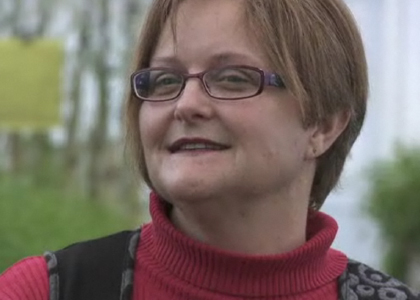Emissions messiah misses agricultural greenhouse gases

Climate Hero: Dr Kerrie Hancock, working unpaid in her own time, cracked the white clover holy grail by identifying the gene, in the related rabbit-foot clover, to turn on to produce low-emissions pasture. image TVNZ 7
On the face of it, New Zealanders have a light carbon footprint.
Even Dr James Hansen, in his open letter to the prime minister, says that:
New Zealand contributes relatively little to carbon emissions that drive climate change. Per capita fossil fuel emissions from New Zealand are just over 2 tons of carbon per year, while in my country fossil fuel carbon emissions are about 5 tons per person.
Because there are so few New Zealanders, Aotearoa is ranked 72nd globally, producing a mere 0.11% of the world’s total carbon dioxide that results from fossil fuels and cement. There are gases, however, that are much more potent than carbon dioxide, when it comes to the greenhouse effect. Methane traps 21 times more heat, while nitrous oxide traps about 300 times more, and
…is the leading human-caused threat to the atmospheric ozone layer, which protects the earth from the sun’s harmful ultraviolet radiation.
But even when factoring in agriculture, New Zealanders are more light-footed than Americans—11.4 tonnes carbon dioxide equivalents, compared with 28.6 tonnes. The trap with using carbon as shorthand for anthropogenic greenhouse gases is that it is the affect of the additional greenhouse gases, rather than carbon per se that is the problem. And it has played into the hands of the propagandists who claim methane is the epitome of carbon neutrality:
The same amount of carbon has cycled from the atmosphere and back again. So without any extra being added, it’s carbon neutral, right?
As the National Institute of Water and Atmospheric Research points out, when it comes to their effect on the greenhouse, all carbons don’t behave the same way. Undeterred, rural newspapers seem determined to beat the carbon-neutral drum until the cows come home.
The issue is that pastoral farming does add substantially to atmospheric methane, which is second only to atmospheric carbon dioxide in causing global warming. When it comes to pulling its weight to reduce global emissions, Aotearoa has two choices. It can either do a little of everything or it can take a strategic approach and concentrate its resources on making a major contribution in areas where its industry is vulnerable to being identified as a high emitter. And it makes perfect sense from both moral and pragmatic perspectives. Setting aside the moral perspective—folk either feel a responsibility to not defraud future generations, or not—there are abundant reasons to reduce pastoral emissions:
- Reducing methane output from ruminants is likely to result in increased production. The methane the average cow burps each year is the carbon dioxide equivalent of using 860 litres of petrol.
- Low-emissions pastoral products have a strong edge for exporters—free range and low emissions. Regardless of its dubious basis, Aotearoa’s clean–green marketing was always going to lose potency as the world’s focus shifted from mere green concerns to the enormity of warming.
- Low-emissions pastoral technology is an obvious export earner for Aotearoa.
This is exactly what the National-led government has put in place, not that anybody reading Dr Hansen’s letter would appreciate the fact. Which is highly unfortunate, leaving the impression that the New Zealand Agricultural Greenhouse Gas Research Centre is of little significance. Yes, Dr Hansen is entirely right to join the environment commissioner in urging Prime Minister Key to leave the lignite in the ground, and he is also correct to advocate:
a flat rising carbon fee collected from fossil fuel companies domestically, with the funds distributed uniformly to citizens, thus moving the world toward the carbon-free energies of the future.
But by failing to mention the Key-led government’s $50 million commitment to reducing pastoral emissions while urging the prime minister to show leadership, Dr Hansen risks appearing ill-informed or unwilling to give credit where (carbon) credit is due.
Aotearoa has its own science heroes. And, if runaway global warming is averted, they will well deserve their place in history. Their number, along with the prime minister’s chief science advisor, will include Dr Kerrie Hancock. In a halfway rational world, field trials of Dr Hancock’s low-emission white clover would by now be well underway, and in Aotearoa.
Now there’s a great question for a green political candidate.

Your article on agricultural greenhouse gases is very pertinent. Dr Kerrie Hancock’s work on low-emission white clover is a very significant research finding. Methane is indeed bad news for the ozone layer at 21 times carbon dioxide. Let us remember that nitrous oxides are far worse, at 300 times carbon dioxide. Nitrous oxide is the most significant pollution gas output of internal combustion combustion engines. Diesel engines are significantly worse polluters than petrol engines. This leaves me wondering if it is wise to change from petrol engines to diesel engines, even if they are nearly twice as economical with their hydrocarbon requirements. Even if we are global warming sceptics, then we are still killing ourselves with hydrocarbon pollutants. We must reduce our hydrocarbon consumption now.